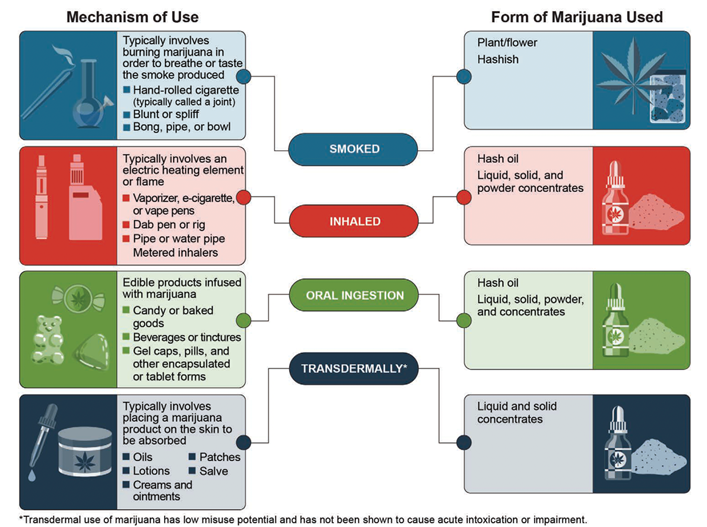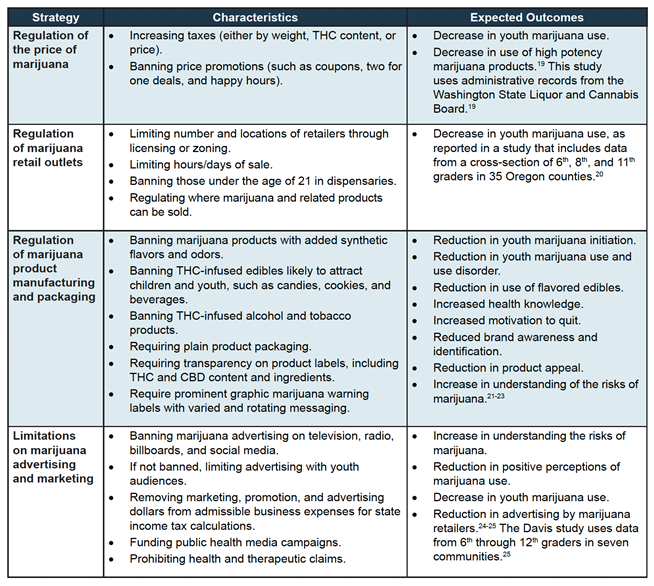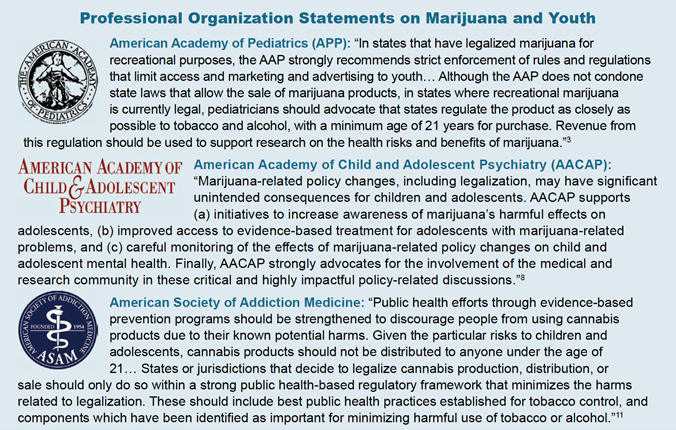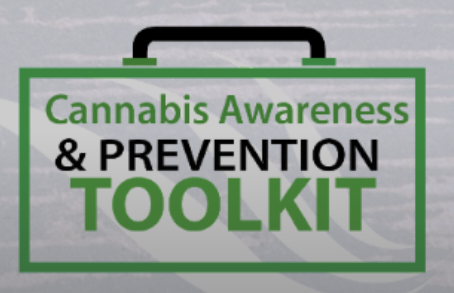Marijuana (Cannabis) Legalization: Implications for Youth Use Prevention
 Despite increasing legalization, laws in every state still prohibit teens from possessing or using marijuana for recreation. Virginia law, for example, carries a penalty for anyone under 21 years of age found in possession of marijuana or marijuana products in public.
Despite increasing legalization, laws in every state still prohibit teens from possessing or using marijuana for recreation. Virginia law, for example, carries a penalty for anyone under 21 years of age found in possession of marijuana or marijuana products in public.
So why has daily marijuana use increased significantly among middle school and young high school students since 2018?
Efforts to legalize marijuana across the country, mixed media messages of popular culture promulgated through television, music, and social media, the acceptable uses of non-psychoactive CBD, and the promotion of vaping, increase the availability to youth and contribute to a misperception that marijuana is a harmless, all natural, non-addictive substance with no serious side effects.
Studies on adolescent behavior have found that as teens’ perception of risk decreases, their risk-taking behavior (e.g., marijuana use) increases. This is of concern because the evidence shows that early marijuana use is associated with
- Negative impacts on brain development (neuropsychological and neurodevelopmental decline),
- poor school performance,
- increased school drop-out rates,
- increased risk for psychotic disorders in adulthood,
- increased risk for later depression, and
- suicidal ideation or behavior.
- dual use of marijuana and tobacco (nicotine)
National & Virginia Youth Marijuana Use Data
2020 National Survey on Drug Use and Health:
- 1 out of 5 people aged 12 or older in the US engaged in past year illicit drug use, with 84 percent of those reporting using Marijuana.
2020 Monitoring the Future Survey (NIDA):
- 35% of 12th graders, 28% of 10th graders, and 11.4% of 8th graders have used marijuana in the past year.
- 6.9% of 12th graders, 4.4% of 10th graders, and 1.1% of 8th graders, use marijuana on a daily basis.
- The percentage of teens who vaped marijuana in the past 12 months increased slightly between 2019 and 2020 after a marked increase from 2017.
- In 2020, 8% of 8th graders, 19% of 10th graders, and 22% of 12th graders reported that they vaped marijuana in the past 12 months.
- The percentage of 10th graders reporting daily or near-daily marijuana vaping decreased significantly between 2019 and 2020.
- Less than 1% of 8th graders, 1.7% of 10th graders and 2.5% of 12th graders report daily or near daily vaping of marijuana in 2020 compared to .8% of 8th graders, 3% of 10th graders and 3.5 % of 12th graders in 2019.
2019 High School Youth Risk Behavior Survey:
- 17% of Virginia high school students currently use marijuana (2019).
What is marijuana?
Marijuana, also known as Cannabis, is made up of seeds, leaves, flowers, and stems from the cannabis plant. People use it in several forms, including dried and smoked, vaped, or ingested in baked goods. Marijuana contains over 400 hundred chemicals. Two main chemicals are non-psychoactive CBD (Cannabidiol) and psychoactive THC (Delta-9-tetrahydrocannbidio). Research studies show that, while CBD is non-addictive and non-intoxication, THC, however, is addictive and can have adverse effects on the brain.
How does marijuana work?
According to the National Institute on Drug Abuse, THC’s chemical structure is similar to a brain chemical called anandamide. Anandamide and other endogenous (internal) cannabinoids engage molecules called cannabinoid receptors in the brain and send chemical messages between nerve cells (neurons) throughout the nervous system. They affect brain areas that influence pleasure, memory, thinking, concentration, movement, coordination, and sensory and time perception.
Because of its similarity to anandamide, THC can also attach to cannabinoid receptors on neurons in these brain areas and activate them, disrupting various mental and physical functions. The neural communication network that uses these cannabinoid neurotransmitters, known as the endocannabinoid system, plays a critical role in the nervous system’s normal functioning, so interfering with it can have profound effects.
One such way is that THC, acting through cannabinoid receptors, activates the brain’s reward system, which includes regions that govern the response to healthy pleasurable behaviors such as sex and eating. Like most other drugs that people misuse, THC stimulates neurons in the reward system to release dopamine, a signaling chemical, at levels higher than typically observed in response to natural rewarding stimuli. This surge of dopamine creates a high or feeling of pleasure, and “teaches” the brain to repeat the rewarding behavior, helping account for marijuana’s addictive properties. The developing adolescent brain relies heavily on the brain’s reward center, which makes teens more sensitive to the effects of dopamine and at greater risk of addiction.
Short and Long-term Consequences of Youth Marijuana Use
In addition to the risk of addiction, marijuana use leads to other short- and long-term consequences. Short-term effects from marijuana use include feelings of relaxation or demotivation; increased heart rate; loss of coordination and slower reaction times; altered sense of time; increased appetite; and feelings of anxiety, fear, distrust, and panic. Marijuana use over a long period of time can cause respiratory problems and make it difficult to retain and process information.
Marijuana use among teens increases the risk of academic and athletic failure. THC impacts the hippocampus, a part of the brain responsible for cognitive functions including attention, critical thinking, processing, and storing new information. Impaired focus and concentration have serious implications for student learning and achievement. In addition, marijuana use among teens has also been linked to lack of motivation, which may be the cause for school absences and drop-out rates.
THC also affects parts of the brain that control motor skills such as reflexes and coordination, which are critical for athletic performance. Even cognitive and motor functions that are diminished for a short period of time can increase the risk of a serious injury, which has implications for youth sport concussions.
Academic and athletic performance are not the only areas affected by marijuana use. Many teens will learn to drive an automobile during their adolescent years, which makes safe driving a serious concern. The same capabilities that teens need to perform well in school and in sports, such as concentration, critical thinking, and motor skills are the same skills necessary for safe driving. THC impairs these functions and can increase the risk of crashes.
How is Marijuana Used?
In order to effectively prevent youth marijuana use, it is important to understand how it is used. SAMHSA Evidence Based Resource Guide Series: Preventing Marijuana Use Among Youth provides the following information on how marijuana is used:
How people use marijuana has changed substantially over the years. In addition to smoking traditional marijuana cigarettes, a vast array and combinations of manufactured products have evolved. These include edibles, marijuana-infused beverages, topical applications, and various devices for inhalation. There has also been an increase in people using products originally designed for nicotine/tobacco for marijuana, such as blunts, vaporizing devices, and e-cigarettes. Youth are using marijuana via all of these routes, especially edibles and concentrates.
The graphic below shows the variety of ways people can consume marijuana.

Youth who ingest edibles are at increased risk of adverse events in part because the THC concentration can vary across products and batches of a single product. Consumption also has a delayed rate of absorption compared to other routes of administration. As a result, youth may not know how the amount of THC will affect the body. This is relevant because of the variability in how much and how quickly THC is absorbed in the body.
Foods and beverages can be infused with THC, including products such as brownies and cookies, candies such as gummies and lollipops, sodas, and alcoholic beverages such as wine and beer. Edible marijuana products are especially attractive to youth, as their packaging often look very similar to that of non-marijuana products. Marijuana-infused beverages, often with sweet flavors such as orange soda are known to attract teens, especially girls.
Of note, the timing of a THC high from edibles is different from that of inhaled/smoked sources; it can take 1 to 2 hours to feel an effect from edibles, and peak effects occur later and may last for several hours. When the high is felt and how long it lasts depends on a user’s metabolism, the product formulation, what the person ate, and the dose consumed. Overconsumption can lead to severe intoxication and overdose.
Vaping liquid marijuana products can lack the characteristic smell of marijuana, making detection of use difficult. Vaping devices are also packaged in ways that resemble memory sticks or other non-drug paraphernalia devices. Detection-free use may be one reason why vaping marijuana has become increasingly popular among youth.
Marijuana products, such as vaping concentrates or hemp wrappers used for blunts, may be flavored. This is a strategy well documented to attract youth to tobacco products and is associated with over 80 percent of youth tobacco initiation. Marijuana products also frequently use names implying fruit or other flavors (e.g., grape, peanut butter cup, or pineapple haze), even if that fruit/ flavor is not present.
Promising Environmental Strategies to Prevent Youth Use – Lessons from Other States
Despite the relaxing of social norms and policies, marijuana is a significant youth public health concern. This table from Preventing Marijuana Use Among Youth identifies promising environmental prevention strategies being used across the US. These state and local strategies aim to increase penalties and price, and decrease the availability, attractiveness, and promotion of youth marijuana use.

The increasing access to marijuana is concerning to several national health organizations that have issued statements to caution about risks to youth and urge a range of strategies to be deployed to minimize harm to youth (see the three statements below from Preventing Marijuana Use Among Youth).

 Instructional Ideas - Resources for Preventing Youth Marijuana Use
Instructional Ideas - Resources for Preventing Youth Marijuana Use
- Marijuana Use Prevention YouTube Playlist
- Youth Marijuana Prevention Training (PPT)
- Ask, Listen, Learn - Lesson 8: How Marijuana Affects the Developing Brain (Lesson Plans)
- CDC: Marijuana Fast Facts and Fact Sheets
- CDC: What You Need to Know About Marijuana Use in Teens
- DEA: Resources for Educators (Lesson Plans)
- DEA: Smoking Marijuana and Driving
- ETR: Marijuana: Get the Facts (High School Lesson Plan)
- ETR: Marijuana: What’s the Truth (Middle School Lesson Plan)
- Harvard: Teens Who Smoke Pot at Risk for Later Schizophrenia, Psychosis
-
 NIDA: Exploring Drug Effects on Teens Videos
NIDA: Exploring Drug Effects on Teens Videos - NIH: Mind Matters: The Body’s Response to Marijuana
- NIDA: For Teens - Brain and Addiction
- Partnership to End Addiction: Marijuana: What You Need to Know to Help Protect Children, Teens and Young Adults
- Project Here - Marijuana Lesson Plans
- SAMHSA: Learn About Marijuana Risk
- Stanford Medicine: Cannabis Awareness and Prevention Toolkit
- Scholastic - Drugs and the Teen Brain, Teacher’s Guide (PDF)
- Scholastic - Marijuana Facts: Breaking Down the Myths
- Scholastic -The Science of Marijuana, Teacher’s Edition Lesson Plan
- Youth Marijuana Prevention - Johnny’s Ambassadors

